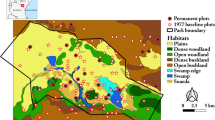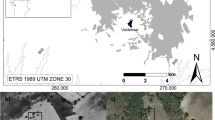Abstract
There are many similarities between Spanish and Californian Quercus woodlands and savanna. Both are located in Mediterranean climate zones, and are used predominantly for livestock grazing. The Californian overstory is dominated by one or a combination of five Quercus species and their hybrids: Quercus douglasii H.&A., Q. agrifolia Nee., Q. wislizenii A.DC., Q. lobata Nee., and Q. englemennii Greene (blue, coast live, interior live, valley, and Englemann oaks). In southern Spain and Portugal, Quercus woodland overstory is predominantly one or a combination of two Quercus species, Quercus ilex L. (holm oak) and Quercus suber L. (cork oak). The underlying natural and semi-natural ecological dynamics of the Quercus woodlands of Spain and California are different, and it follows that the management practices employed also differ. The greatest point of contrast between California and Spain is in the intensity and diversity of management goals and practices. A state-transition model for comparing the ecological dynamics of Quercus woodlands and savanna in California and southern Spain is developed and examined. The highly simplified model is an analytic tool of use in organizing research and developing management practices. States are reached and maintained in different ways in Spain and California, but their appearance and their function in each landscape are quite similar.
Similar content being viewed by others
References
Allen-Diaz, B. H., Holzman, B. & Evett, R. 1991. A classification system for California's hardwood rangelands. Hilgardia 59 (2): 1–45.
Anderson, J. E. 1986. Development and structure of sagebrush steppe plant communities. p. 10–12. In: P. J., Joss, P. W., Lynch, and O. B., Williams (eds.); Rangelands: A Resource Under Siege. Australian Academy of Science, Canberra, Australia.
Bartolome, J. W., Muick, P. C. & McClaran, M. P. 1988. Natural regeneration of Californian hardwoods. In: Plumb, T. R. and N. H. Pillsbury (Tech. Coord.) Proc. Symp. Multiple-use management of California's hardwood resources. USFS Gen. Tech. Rep. PSW-100.
Bartolome, J. W. 1991. The changing natural landscape of Yosemite Valley, Proc. 17th Annual Natural Areas Conference, Concord, California, Oct. 14–19, 1990 (in press).
Biswell, H. H. 1974. Effects of fire on chaparral. In: T. T., Kozlowski and C. E., Ahlgren (eds.) Fire and ecosystems. Academic Press, N. Y. pp. 321–364.
Block, W. M., Morrison, M. L. & Verner, J. 1990. Wildlife and oak-woodland interdependency. Fremontia 18 (3): 72–76.
Campos Palacin, P. 1984. Economia y energia en la dehesa extremena. MAPA, Madrid.
Ewing, R. A., Tosta, N., Tuazon, R., Huntsinger, L., Marose, R., Nielson, K., Motroni, R. & Turan, S. 1988. The California forest and rangeland resources assessment: growing conflict over changing uses. California Department of Forestry and Fire Protection Sacramento, CA, Anchor Press; 348 p.
Foin, T. C. 1986. Succession, climax and range evaluation in the California coastal prairie ecosystem. p. 5–7. In: P. J., Joss, P. W., Lynch, and O. B., Williams (eds.), Rangelands: A Resource Under Siege. Australian Academy of Science, Canberra, Australia.
Griffin, J. R. 1977. Oak woodland. In: Barbour, M. G. and J., Major (eds.) Terrestrial vegetation of California. New York, John Wiley and Sons: pp. 383–416. 1020 p.
Heady, H. F. & Zinke, P. J. 1978. Vegetational change in Yosemite Valley. United States National Park Service Occ. Pap. #5. 25 p.
Holzman, B. & Allen-Diaz, B. H. 1991. Vegetation change in blue oak woodlands in California. In: Standiford, R. (eded.) Proc. Symp. on oak woodlands and hardwood rangelands: a research symposium. Oct. 31–Nov. 2, Davis, CA. USFS Gen. Tech. Rep. PSW-126; pp. 189–193.
Huntsinger, L., Bartolome, J. W. & Starrs, P. F. 1991. A comparison of management strategies in the oak woodlands of Spain and California. In: Standiford, R. (ed.) Proc. Symp. on oak woodlands and hardwood rangelands: a research symposium. Oct. 31–Nov. 2, Davis, CA. USFS Gen. Tech. Rep. PSW-126; pp. 300–306.
Jackson, L. E. & Roy, J. 1986. Growth patterns of Mediterranean annual and perennial grasses under simulated rainfall regimes of southern France and California. Oecologia Plantarum 7: 191–212.
Jackson, L. E. & Roy, J. 1989 Comparative ecology of annual grasses: native versus California habitats. In: L. F., Huenneke and H., Mooney (eds.) Grassland structure and function: California annual grassland. Kluwer Academic Publishers, Dordrecht, Neth. pp. 81–91.
Joffre, R., Vacher, J., de los, Llanos, C. & Long, G. 1988. The dehesa: an agrosilvopastoral system of the Mediterranean region with special reference to the Sierra Morena area of Spain. Agroforestry Systems 6: 71–96.
Marañon, Teodoro. 1988. Agro-sylvo-pastoral systems in the Iberian Peninsula: dehesas and montados. Rangelands 10 (6): 255–258.
Marañon, Teodoro, 1986. Plant species richness and canopy effect in the savanna-like ‘dehesa’ of S.W. Spain. Ecologia Mediterranca 12: 131–141.
Martin Bolaños, M. & Guinea, E. 1949 Jarales y Jara. Ministerio de Agricultura. Instituto Forestal de Investigaciónes y Experiencias Madrid, Año XX, no. 49. 221 pgs.
McClaran, M. P. & Bartolome, J. W. 1988. Effect of Quercus douglasii (Fagaceae) on herbaceous understory along a rainfall gradient. Madrono 36: 141–153.
Mentis, M. T. 1986. Range dynamics by classical succession and strategic modelling. p. 19–21. In: P. J., Joss, P. W., Lynch, and O. B., Williams (eds), Rangelands: A Resource Under Siege. Australian Academy of Science, Canberra, Australia.
Montoya Oliver, J. M. 1989. Eneinas y Encinares. Ediciones Mundi-Prensa, Madrid, Spain. 131 pgs.
Nobel, I. R. 1986. The dynamics of range ecosystems, p. 3–5. In: P. J., Joss, P. W., Lynch, and O. B., Williams (eds), Rangelands: A Resource Under Siege, Australian Academy of Science, Canberra, Australia.
Nuñez, E., Cabzas, J. & Escudero, J. C. 1986. Relación de matorrales en la formación de dehesas. Función de la jara, valoración de su bimasa y su utilización industrial. pp. 111–118. In: Campos Palacin, P. and Martin Bellido (coords.) Conservation y desarrolo de las dehesas portuguesa y española. Secretaría General Técnica, Ministerio de Agricultura, Pesca y Alimentación. January 27, 28, 29, Badajoz, Spain.
Parsons, J. J. 1962. The acorn-hog economy of the oak woodlands of southwestern Spain. Geographical Review 52: 211–235.
Pineda, F. D., Nicolas, J. P., Pou, A. & Galiano, E. F. 1981. Ecological succession in oligotrophic pastures of central Spain. Vegetatio 44: 165–175.
Ruiz, M. 1986. Sustainable food and energy production in the Spanish ‘dehesa’. Paris, The United Nations University.
Sampson, A. W. & Jesperson, B. S. 1963. California range brushland and browse plants. Calif. Agric. Expt. Sta. Manual #33, 162 p.
Schultz, A. M., Launchbaugh, J. L. & Biswell, H. H. 1955. Relationship between grass density and brush survival. Ecology 36: 226–238.
Standiford, R. & Howitt, R. E. 1991. A dynamic model of California's hardwood rangelands. In: Standiford, R. (ed.) Proc. Symp. on oak woodlands and hardwood rangelands: a research symposium. Oct. 31–Nov. 2. Davis. CA. USFS Gen. Tech. Rep. PSW-126; pp. 279–285.
Westoby, M., Walker, B. & Noy-Meir, I. 1989. Opportunistic management for rangelands not at equilibrium. J. of Range Mgt. 42: 266–274.
Author information
Authors and Affiliations
Rights and permissions
About this article
Cite this article
Huntsinger, L., Bartolome, J.W. Ecological dynamics of Quercus dominated woodlands in California and southern Spain: a state-transition model. Vegetatio 99, 299–305 (1992). https://doi.org/10.1007/BF00118237
Accepted:
Issue Date:
DOI: https://doi.org/10.1007/BF00118237




